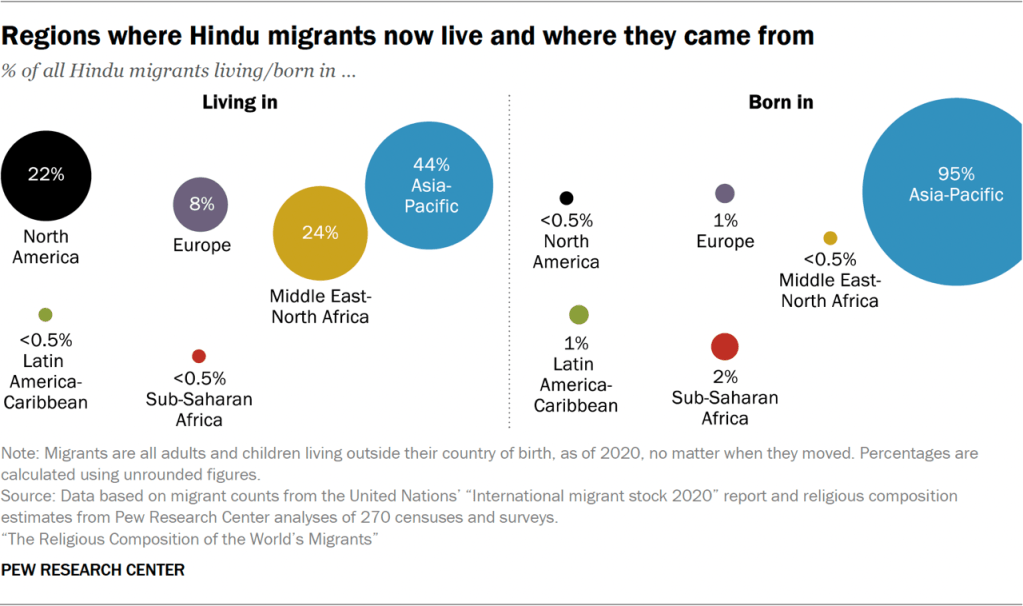The United Nations counts international migrants as people of any age who live outside their country (or in some cases, territory) of birth – regardless of their motives for migrating, their length of residence or their legal status.
In addition to naturalized citizens and permanent residents, the UN’s international migrant numbers include asylum-seekers and refugees, as well as people without official residence documents. The UN also includes some people who live in a country temporarily – like some students and guest workers – but it does not include short-term visitors like tourists, nor does it typically include military forces deployed abroad.
For brevity, this report refers to international migrants simply as migrants. Occasionally, we use the term immigrants to differentiate migrants living in a destination country from emigrants who have left an origin country. Every person who is living outside of his or her country of birth is all three – a migrant, an immigrant and an emigrant.
The analysis in this report focuses on existing stocks of international migrants – all people who now live outside their birth country, no matter when they left. We do not estimate migration flows – how many people move across borders in any single year.
Hindu migrants make up a small share of all international migrants (5%), with 13 million Hindus living outside their country of birth, as of 2020. Hindus are underrepresented among international migrants compared with their share of the global population (15%).
Hindus, on average, travel longer distances from origin to destination countries than any of the other groups in this analysis, including Buddhists – who also mostly originate from Asia. Hindu migrants move an average of 3,100 miles from their country of origin, compared with an average of 2,200 miles among migrants overall.
Many Hindu migrants live in the Asia-Pacific region (44%). The next most common destinations for Hindu migrants are the Middle East-North Africa region (24%) and North America (22%). About 8% of Hindu migrants live in Europe, and very few live in Latin America or sub-Saharan Africa.
Asia-Pacific is their most common region of origin: Virtually all Hindu migrants (95%) were born in this area. Small shares of Hindu migrants come from sub-Saharan Africa (2%) and Europe (1%), and even fewer were born in the Middle East-North Africa or the Americas.
Destinations
India, where Hindus form a religious majority, is the leading destination for Hindu migrants. Fully 22% of Hindu migrants (3 million) have moved to India.
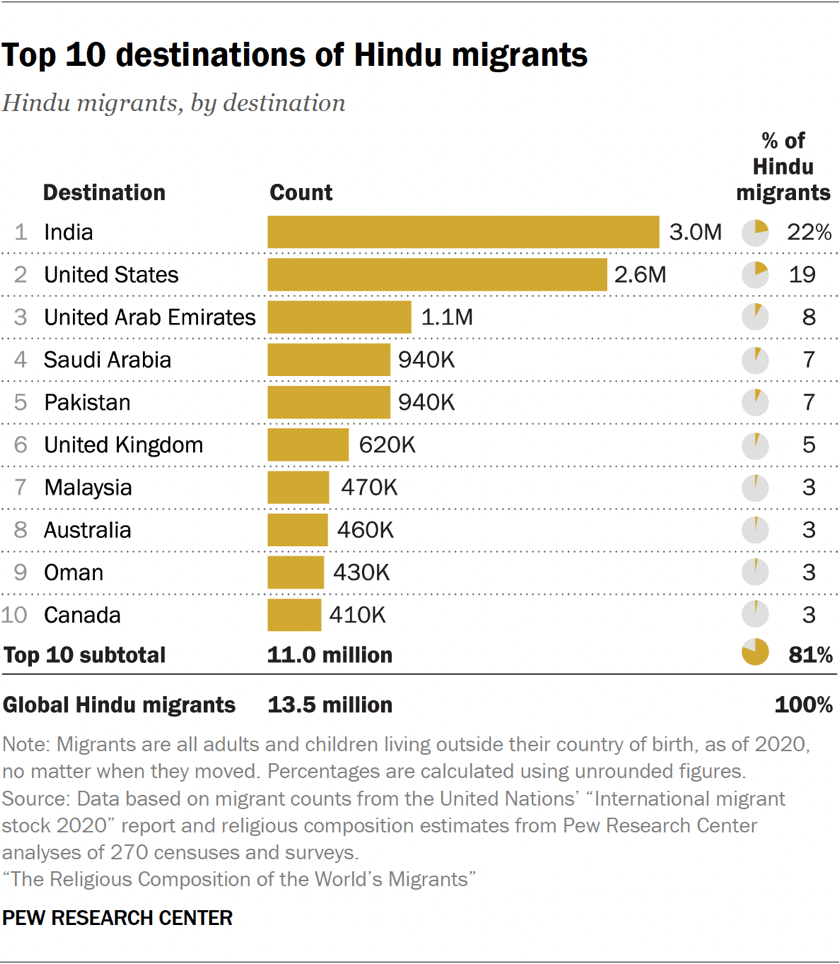
This dynamic – like other patterns in this chapter that describe movement of Hindus in and out of India, Pakistan and Bangladesh – is largely the result of India’s Partition at the end of British rule. In 1947, the Indian subcontinent was divided into majority-Hindu India and majority-Muslim Pakistan. In 1971, Bangladesh separated from Pakistan.
As a result of this redrawing of borders, millions of Hindus who were living in what became Pakistan and Bangladesh moved to what is now India, while millions of Muslims who were living in what is now India moved to modern-day Pakistan or Bangladesh.
For decades after that, the number of Hindu migrants living in India remained high, though it has been declining recently as the generation of Hindus who moved during Partition gradually dies.
Outside India, the United States has the most foreign-born Hindus (2.6 million), accounting for 19% of them. Other popular destinations for Hindu migrants include the United Arab Emirates and Saudi Arabia, where they are often temporary workers, though many routinely renew their work permits.
The only countries aside from India in which Hindus are the largest group of migrants are Nepal and Bhutan. However, these countries have relatively small populations overall, and they are not among the top destinations for Hindu migrants. And only one of India’s neighboring countries, Pakistan, is among the top 10 destinations for Hindu migrants (940,000).
Origins
India, the world’s second-most populous country in 2020, is by far the leading source of Hindu migrants, with 7.6 million Hindus born in India now living elsewhere.
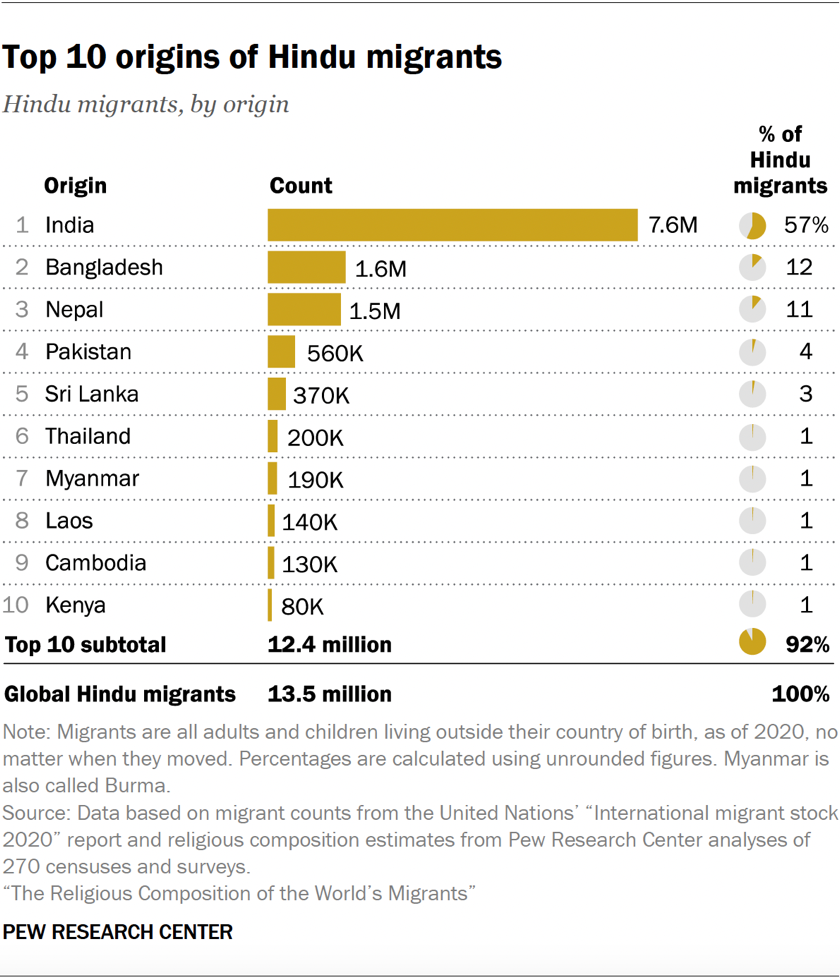
But Hindus are less likely to leave India than they are to leave many places where they are a religious minority. Even though India is home to 94% of the world’s Hindus, it is the source of only 57% of the world’s Hindu migrants.
Bangladesh – a majority Muslim country – is the second-most common origin of Hindu migrants. About 1.6 million Hindus born in Bangladesh now live elsewhere, accounting for 12% of all Hindu migrants. (Bangladesh was part of India before the 1947 Partition.)
Nepal – whose large Hindu population is second only to India’s – is the third-most common source of Hindu migrants. About 1.5 million, or 11% of Hindu migrants, were born in Nepal.
Pakistan, India’s Muslim-majority neighbor, is the fourth-most common birthplace of Hindu migrants. (Like Bangladesh, Pakistan was part of British-controlled India before Partition.)
Hindus are far more likely to have left Bangladesh and Pakistan than they are to have left India or Nepal. Hindus form a small minority of the overall population in Bangladesh (8%) and Pakistan (2%), but they make up 21% and 8% of international migrants from those countries, respectively. On the other hand, Hindus form large majorities in India (79%) and Nepal (81%), but they make up only 41% and 56%, respectively, of migrants leaving those places.
Country pairs
The most popular pathway for Hindu migrants around the world is to move from India to the U.S. About 1.8 million Hindus have taken this route, making up 61% of all Indian immigrants in the U.S. as of 2020.
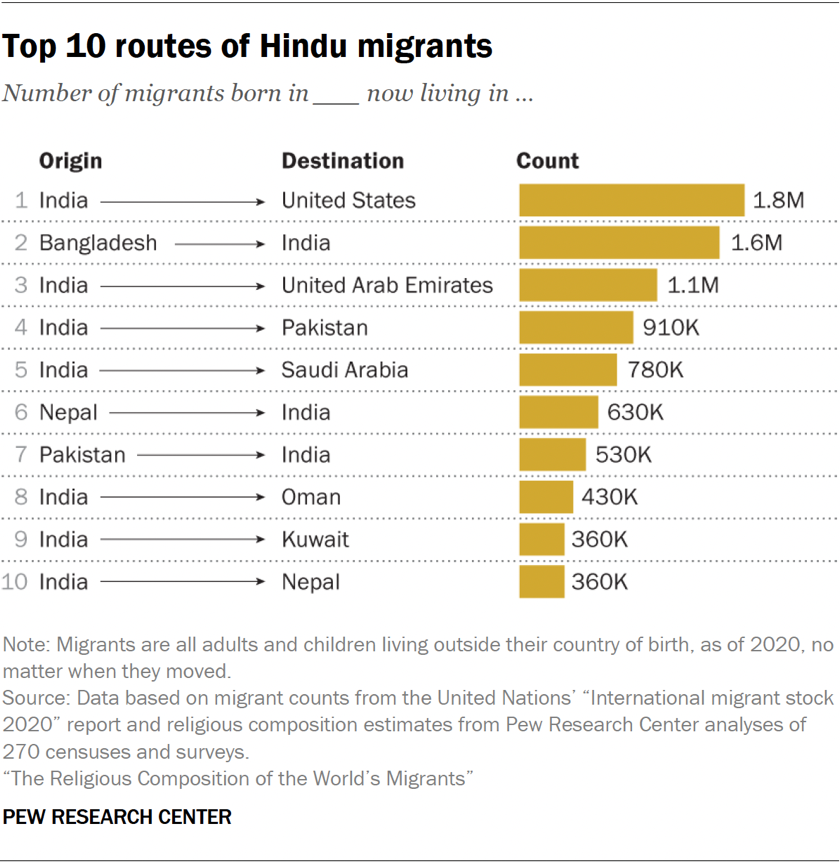
Like other Indian immigrants, many Hindus arrive in the U.S. for employment and family reunification. They often have higher levels of education and higher family incomes than those who remain in India. The second-most common route for Hindu migrants is from Bangladesh to India. Nearly 1.6 million Hindus born in Bangladesh now live in India, and many of them were part of the mass migration following the 1947 Partition of India.
If the members of the Gulf Cooperation Council (GCC) – Bahrain, Kuwait, Oman, Qatar, Saudi Arabia and the UAE – were considered a single destination, a move from India to the GCC would be by far the most common one for Hindus. Roughly 3 million Hindus from India live in GCC countries, where foreign workers comprise half or more of the area’s workforce. (Read “Spotlight on the Gulf Cooperation Council countries” for more.)
Change since 1990
The total stock of Hindu migrants living around the world increased from 9.1 million in 1990 to 13.5 million in 2020 (up 48%). But Hindu migrants grew less than migrants overall (up 83%).
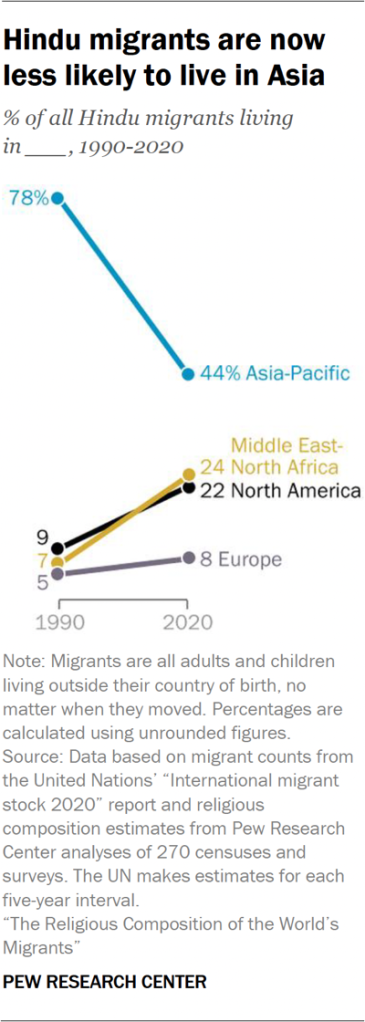
While Hindus have consistently made up between 5% and 6% of the international migrant population during these decades, their regional patterns have changed considerably. In 1990, nearly eight-in-ten Hindu immigrants lived in the Asia-Pacific region. By 2020, that share had dropped to less than half.
This change is partly because many migrants who moved during Partition had died by 2020. Three decades earlier, about 4 million Hindus who had been born in Pakistan or Bangladesh were residing in India. By 2020, the number had roughly halved, to 2.1 million.
Meanwhile, the number of Hindu migrants living in other parts of the world has grown steadily.
In the Middle East-North Africa region, the number of foreign-born Hindus increased from roughly 0.7 million in 1990 to 3.3 million in 2020 (up 387%). This includes many who moved to GCC countries for work. Of the six GCC countries, Qatar saw the most growth in percentage terms: The number of Hindu migrants there rose more than 24,000%, from around 1,000 in 1990 to 290,000 in 2020. In sheer numbers, the UAE saw the steepest increase among the GCC countries; the number of Hindu migrants there grew from 140,000 to 1.1 million (up 673%) during this timespan.
North America also saw a sharp rise in Hindu migrants over this period, from 0.8 million to 3.0 million (a 267% increase). This was driven primarily by a rise in the number of India-born Hindus living in the U.S., from 0.3 million to 1.8 million.
Within the Asia-Pacific region, the stock of Hindu migrants living in Malaysia grew more than 15 times, from 30,000 to 470,000 (an increase of over 1,700%). This was driven primarily by migrant workers from Nepal who arrived in search of jobs. In 2020, Malaysia was the seventh-largest destination for Hindu migrants.
Refer to our “Geographic spotlights” section for in-depth analyses of migration in India and the GCC countries.

